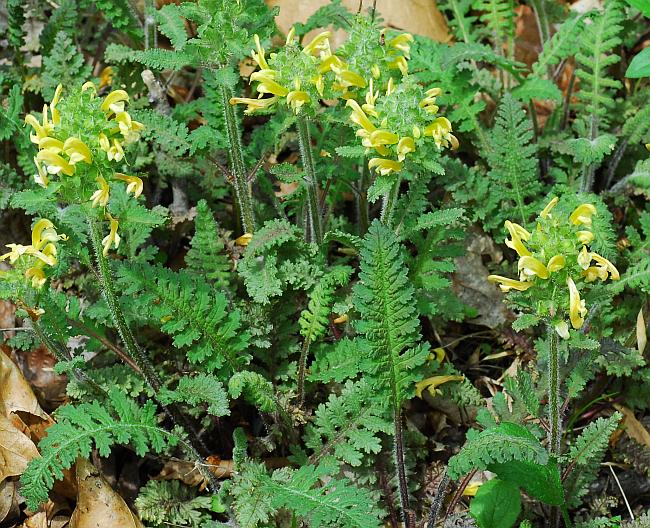Pedicularis canadensis L.
Common Lousewort

Native
CC = 5
CW = 3
MOC = 65
© SRTurner
Pedicularis canadensis L.Common Lousewort | |
 |
Native CC = 5 CW = 3 MOC = 65 |
© SRTurner |
|
Family - Orobanchaceae Habit - Rhizomatous perennial forb, sometimes with stolons, often colonial, hemiparasitic. Stem - Erect, to 30 cm, usually unbranched, sparsely hairy toward the base, densely hairy or appearing woolly toward the tip and inflorescence axis.
Leaves - Basal and alternate. Basal leaves well-developed at flowering, long-petiolate. Stem leaves mostly alternate. Lower stem leaves long-petiolate. Leaf blades 2-9 cm long, lanceolate to oblanceolate, moderately to deeply lobed, those of the larger leaves lobed more than halfway to the midvein, the lobes finely toothed or scalloped to lobed again, usually with a narrow, thickened pale band along the margins, the surfaces sparsely hairy to nearly glabrous.
Inflorescence - Terminal spikes or spikelike racemes, the lowermost bracts leafy, the flower stalks absent or to 3 mm long, relatively short and dense when the first flowers open, continuing to elongate and appearing less dense as the fruits develop.
Flowers - Calyces strongly bilabiate, 7-9 mm long, oblique at the tip, bell-shaped to tubular, the tube with a pair of shallow, rounded teeth at the tip of the upper side, the lower side deeply notched. persistent, not or only slightly enlarged at fruiting. Corollas 18-25 mm long, strongly bilabiate, usually yellow, the upper lip 11-15 mm long, fused into a hooded or helmet-shaped structure, this with a pair of small toothlike lobes near the otherwise truncate tip, the lower lip 7-10 mm long, 3-lobed, the lobes spreading, the central lobe shorter and more pointed, hairy on the inner surface, the lobes glabrous. Stamens hidden under the upper corolla lip, the filaments of 2 lengths, hairy near the base, the anthers with 2 sacs, these parallel, blunt at the ends, light yellow, glabrous. Style curved under the upper corolla lip, sometimes slightly exserted, the stigmatic portion small, capitate, unlobed.
Fruits - Capsules 10-17 mm long, ovoid, glabrous. Seeds 1.6-2.2 mm long, more or less oblong-ellipsoid, not flattened, with a short, sharp point at the tip, truncate to concave at the base, unwinged, the surface with a fine but noticeable network of ridges, brown.
Flowering - April - May. Habitat - Forests, glades, upland prairies, bluffs, fields, roadsides. Origin - Native to the U.S. Lookalikes - None. Other info. - This common springtime species is found across Missouri, and in the continental U.S. almost everywhere east of a sharp longitude roughly coincident with eastern Kansas and Nebraska. It is an easy plant to recognize, appearing like yellow pinwheels when viewed from above. The leaves are also quite distinctive. The closest lookalike, P. lanceolata, grows in wetter habitats and has paler flowers and stem leaves which are mostly opposite. That species also lacks the two small teeth on the upper corolla lip, which are shown in a photograph above. Photographs taken at St. Joe State Park, St. Francois County, MO, 4-26-2014, Young Conservation Area, Jefferson County, MO, 4-12-2017 and 5-4-2018, and Shaw Nature Reserve, Franklin County, MO, 4-30-2021 (SRTurner). |